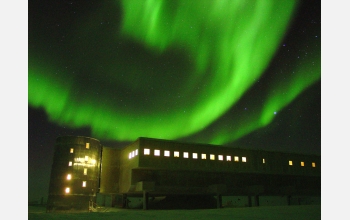Multimedia Gallery
Aurora Australis over Amundsen-Scott Station
Aurora Australis over the National Science Foundation's (NSF) Amundsen-Scott South Pole Station. Aurora Australis is the atmospheric phenomenon known familiarly as the Southern Lights. Like its more familiar counterpart Aurora Borealis--or Northern Lights, the phenomenon is caused by the solar wind passing through the upper atmosphere. Aurora Australis is far less frequently observed however, because so few people live in Antarctica during the austral winter.
This image shows the atmospheric phenomenon over a wing of the new station NSF is building. The new station is adjacent to the existing station and will replace the aluminum dome that has housed NSF's scientific facilities since the 1970's. Amundsen-Scott is one of three U.S. research stations on Antarctica that are maintained by NSF's U.S. Antarctic Program (USAP). In addition to maintaining research stations on the continent, USAP supports research projects in an array of scientific disciplines, including for example, aeronomy and astrophysics, biology and medicine, geology and geophysics, glaciology, and ocean and climate systems. Outreach such as the Antarctic Artists and Writers program and education programs are also supported.
To learn more about Aurora Australis at Amundsen-Scott, see the NSF Media Advisory Rarely Seen "Southern Lights" Over Amundsen-Scott South Pole Station. For more information about USAP, visit the program's website Here. (Date of Image: May 2002) [Image 2 of 3 related images. See Next Image.]
Credit: Jonathan Berry, National Science Foundation
Images and other media in the National Science Foundation Multimedia Gallery are available for use in print and electronic material by NSF employees, members of the media, university staff, teachers and the general public. All media in the gallery are intended for personal, educational and nonprofit/non-commercial use only.
Images credited to the National Science Foundation, a federal agency, are in the public domain. The images were created by employees of the United States Government as part of their official duties or prepared by contractors as "works for hire" for NSF. You may freely use NSF-credited images and, at your discretion, credit NSF with a "Courtesy: National Science Foundation" notation.
Additional information about general usage can be found in Conditions.
Also Available:
Download the high-resolution JPG version of the image. (1.2 MB)
Use your mouse to right-click (Mac users may need to Ctrl-click) the link above and choose the option that will save the file or target to your computer.



